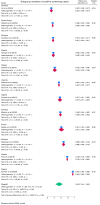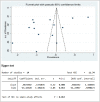Post-traumatic stress disorder and associated factors among internally displaced persons in Africa: A systematic review and meta-analysis
- PMID: 38557637
- PMCID: PMC10984478
- DOI: 10.1371/journal.pone.0300894
Post-traumatic stress disorder and associated factors among internally displaced persons in Africa: A systematic review and meta-analysis
Abstract
Background: Internally displaced people (IDPs), uprooted by conflict, violence, or disaster, struggle with the trauma of violence, loss, and displacement, making them significantly more vulnerable to post-traumatic stress disorder (PTSD). Therefore, we conducted a systematic review and meta-analysis to assess the prevalence and associated factors of PTSD among IDPs in Africa.
Methods: A comprehensive search of electronic databases was conducted to identify relevant studies published between 2008 and 2023. The search included electronic databases such as PubMed, CABI, EMBASE, SCOPUS, CINHAL, and AJOL, as well as other search sources. The Preferred Reporting Items for Systematic Reviews and Meta-Analyses (PRISMA) guidelines were followed. Data were extracted using Microsoft Excel, and analysis was performed using STATA 17 software. The quality of the included studies was assessed using the JBI quality appraisal tool. A random-effects model was used to estimate the pooled prevalence of PTSD and its associated factors. The funnel plot and Egger's regression test were used to assess publication bias, and I2 test statistics was used to assess heterogeneity. The protocol for this review has been registered with PROSPERO (ID: CRD42023428027).
Results: A total of 14 studies with a total of 7,590 participants met the inclusion criteria. The pooled prevalence of PTSD among IDPs in Africa was 51% (95% CI: 38.-64). Female gender (OR = 1.99, 95% CI: 1.65-2.32), no longer married (OR = 1.93, 95% CI: 1.43-2.43), unemployment (OR = 1.92, 95% CI: 1.17-2.67), being injured (OR = 1.94, 95% CI: 1.50-1.50), number of traumatic events experienced [4-7(OR = 2.09, 95% CI: 1.16-3.01), 8-11 (OR = 2.09, 95% CI: 2.18-4.12), 12-16 (OR = 5.37, 95% CI: 2.61-8.12)], illness without medical care (OR = 1.92, 95% CI: 1.41-2.29), being depressed (OR = 2.97, 95% CI: 2.07-3.86), and frequency of displacement more than once (OR = 2.13, 95% CI: 1.41-2.85) were significantly associated with an increased risk of PTSD.
Conclusions: The findings of this systematic review and meta-analysis highlight the alarming prevalence of PTSD among IDPs in Africa. Female gender, marital status, number of traumatic events, ill health without medical care, depression, and frequency of displacement were identified as significant risk factors for PTSD. Effective interventions and the development of tailored mental health programs are needed to prevent PTSD among IDPs, focusing on the identified risk factors.
Copyright: © 2024 Tesfaye et al. This is an open access article distributed under the terms of the Creative Commons Attribution License, which permits unrestricted use, distribution, and reproduction in any medium, provided the original author and source are credited.
Conflict of interest statement
The authors have declared that no competing interests exist.
Figures







Similar articles
-
Post-traumatic stress disorder in the Ethiopian population dwelling in war-affected communities: a systematic review and meta-analysis.Front Psychiatry. 2024 May 9;15:1399013. doi: 10.3389/fpsyt.2024.1399013. eCollection 2024. Front Psychiatry. 2024. PMID: 38784164 Free PMC article.
-
Prevalence of posttraumatic stress disorder and associated factors among displaced people in Africa: a systematic review and meta-analysis.Front Psychiatry. 2024 Mar 5;15:1336665. doi: 10.3389/fpsyt.2024.1336665. eCollection 2024. Front Psychiatry. 2024. PMID: 38516263 Free PMC article.
-
Gender-based violence and its determinants among refugees and internally displaced women in Africa: systematic review and meta-analysis.BMC Public Health. 2024 Oct 16;24(1):2851. doi: 10.1186/s12889-024-20329-8. BMC Public Health. 2024. PMID: 39415129 Free PMC article.
-
A post-traumatic stress disorder among internally displaced people in sub-Saharan Africa: a systematic review.Front Psychiatry. 2023 Nov 3;14:1261230. doi: 10.3389/fpsyt.2023.1261230. eCollection 2023. Front Psychiatry. 2023. PMID: 38025413 Free PMC article.
-
An overview of systematic reviews on mental health promotion, prevention, and treatment of common mental disorders for refugees, asylum seekers, and internally displaced persons.Cochrane Database Syst Rev. 2020 Sep 4;9(9):CD013458. doi: 10.1002/14651858.CD013458.pub2. Cochrane Database Syst Rev. 2020. PMID: 32885850 Free PMC article.
Cited by
-
In-person vs mobile app facilitated life skills education to improve the mental health of internally displaced persons in Nigeria: protocol for the RESETTLE-IDPs cluster randomized hybrid type 2 effectiveness-implementation trial.BMC Health Serv Res. 2024 Oct 22;24(1):1269. doi: 10.1186/s12913-024-11762-x. BMC Health Serv Res. 2024. PMID: 39438885 Free PMC article.
-
Depression, anxiety and its predictor among internally displaced person in metekel Ethiopia, 2023: using a structural equation model.Front Psychiatry. 2025 Jan 22;15:1458939. doi: 10.3389/fpsyt.2024.1458939. eCollection 2024. Front Psychiatry. 2025. PMID: 39911560 Free PMC article.
-
Climate change and suicide epidemiology: a systematic review and meta-analysis of gender variations in global suicide rates.Front Public Health. 2025 Jan 8;12:1463676. doi: 10.3389/fpubh.2024.1463676. eCollection 2024. Front Public Health. 2025. PMID: 39845688 Free PMC article.
-
Post-traumatic stress disorder in the Ethiopian population dwelling in war-affected communities: a systematic review and meta-analysis.Front Psychiatry. 2024 May 9;15:1399013. doi: 10.3389/fpsyt.2024.1399013. eCollection 2024. Front Psychiatry. 2024. PMID: 38784164 Free PMC article.
-
Post-traumatic stress disorder and associated factors among high school students who experienced war in Woldia town.Front Psychiatry. 2024 Jul 16;15:1359370. doi: 10.3389/fpsyt.2024.1359370. eCollection 2024. Front Psychiatry. 2024. PMID: 39081535 Free PMC article.
References
-
- Yigzaw GS, Abitew EB: Causes and impacts of internal displacement in Ethiopia. African Journal of Social Work 2019, 9(2):32–41.
-
- Ibrahim UU, Aliyu AA, Abdulhakeem OA, Abdulaziz M, Asiya M, Sabitu K, et al.: Prevalence of Boko Haram crisis related depression and post-traumatic stress disorder symptomatology among internally displaced persons in Yobe state, North East, Nigeria. Journal of Affective Disorders Reports 2023, 13:100590.
-
- Edition F: Diagnostic and statistical manual of mental disorders. Am Psychiatric Assoc 21, 591–643. In.; 2013.
Publication types
MeSH terms
LinkOut - more resources
Full Text Sources
Medical
Miscellaneous

